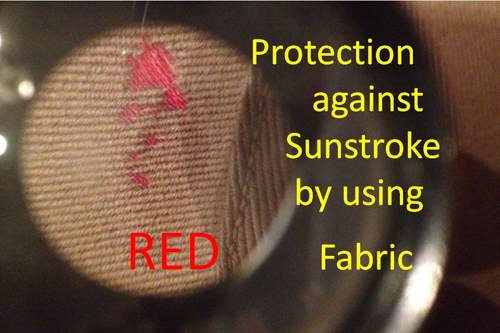 On this website, articles had been published about all kinds of inventions and patents that aimed to increase a sun helmet’s protection against heat. There were many kinds of different ventilation systems, double domes, aluminium foil or spine pads as a prolongation of neck flaps for the back. Now, one more idea was unwillingly and unintentional discovered by moths, that ate pieces of a helmet produced by Tress in London for Abercrombie & Fitch in New York. That is red fabric.
On this website, articles had been published about all kinds of inventions and patents that aimed to increase a sun helmet’s protection against heat. There were many kinds of different ventilation systems, double domes, aluminium foil or spine pads as a prolongation of neck flaps for the back. Now, one more idea was unwillingly and unintentional discovered by moths, that ate pieces of a helmet produced by Tress in London for Abercrombie & Fitch in New York. That is red fabric.
Founded in 1892, A&F had for decades specialized in sporting goods and outdoor equipment. That included the retail of, for example compasses and, of course, sun helmets.
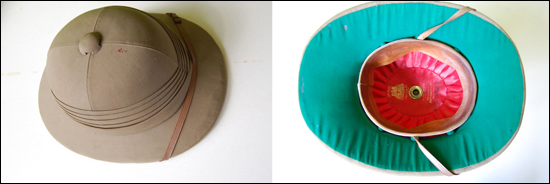
A helmet produced by Tress, London, for Abercrombie & Fitch, New York, in the 20s or 30s. A large red spot is visible right beside the top. (Author’s collection)
When I came across my one in the internet, I was at first a bit disturbed by some ugly red spots visible on the picture. I presumed them to be color or wax. But despite that I decided to buy it. Right so, for the red spots unveiled a most interesting story.
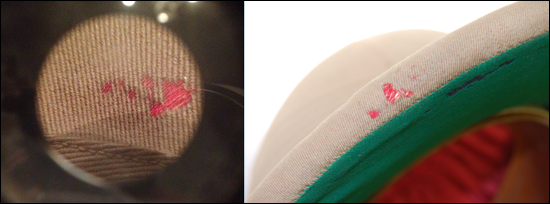
The fabric is woven with red longitudinal threads – the so called warps. These were filled with lateral threads (weft or filling) in a khaki or tan color.
The pictures made through a magnifying lens and by using the micro function of the camera show, that the fabric used to cover the pith is woven with red longitudinal threads – the so called warps. These were filled with lateral threads (weft or filling) in a khaki or tan color. By some reason, the moths did not like and eat the red warps, they preferred the weft. In this way they left, so to say, the skeleton of the fabric. The outer appearance of the helmet – I speak of the undamaged areas – is tan or khaki. Here, only a very close look shows tiny little red spots – the red warps. In weaving technology, this allows to give a fabric any appearance that was wished. Red was surely not wished. But why was red cotton used as lateral thread, not khaki one?
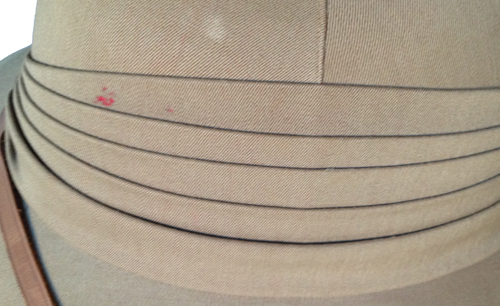
A red shade is clearly visible, though the fabric appears khaki. Note the uncommonly, very thick folded pugaree. (Author’s collection)
The only explanation possible is that this was intended to give additional protection against sun rays. In the 20s or 30s, many companies offered products that used red as a protective color. So did, for example, Aertex.
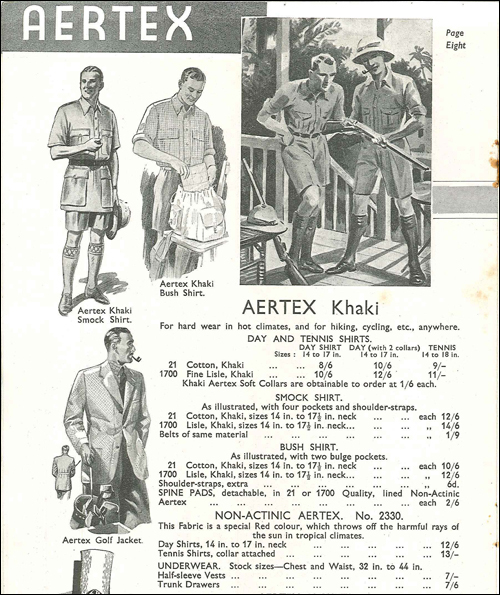
Today, Aertex is more remembered for tropical uniforms used in World War II. In that catalogue, only one page out of 16 presents equipment for colonial services or travelling abroad – besides formal shirts, male and female underwear or children´s clothing.

Among the khaki cloth, so called “NON-ACTINIC” Aertex is offered, colored red, to “throw off the harmful rays of the sun.” A spine pad is offered as well, but only in khaki.
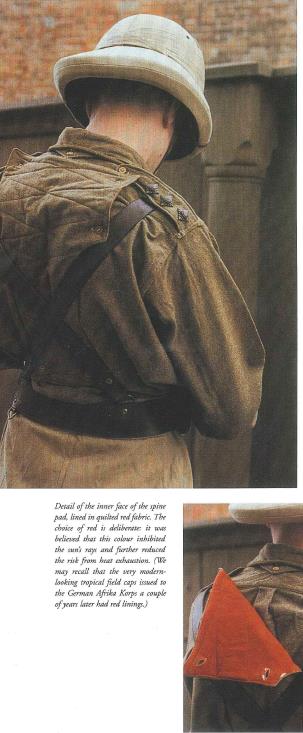 In their fantastic book “Khaki drill and jungle green” Martin J. Brayley and Richard Ingram show an example of a red lined, detachable spine pad (above). For sure not bought from Aertex, for that was – as we learned above – entirely khaki colored.
In their fantastic book “Khaki drill and jungle green” Martin J. Brayley and Richard Ingram show an example of a red lined, detachable spine pad (above). For sure not bought from Aertex, for that was – as we learned above – entirely khaki colored.
The text but puts our mind into the next direction of thinking. Most German tropical headwear in World War II was lined red.
Amongst collectors, a popular explanation for the red lining is, that the cap – within less than 2 seconds, I tried it myself – could be turned inside out. For a plane giving air support, advancing infantry would appear as a line of little red dots in the sand. Enough to distinuish between friend and foe. That may have been a usefull secondary effect. In my opinion, the true reason was an adoptation of the then popolar theory about red color to “throw off the harmful rays of the sun.” Why else should many German sun helmets have had that red lining as well? From the early naval pressed material helmet, to the cork ones to the late felt model. Needless to remind the readers of the military sun helmets side, that all the helmets mentioned can not be turned inside out – at least not more often than one time.
Finally, to come back to the A& F helmet. After my discovery, I inspected all my other helmets closely with a magnifying glas to find red spots. But there was no other example of that specific fabric. The helmet mentioned here is one of Tress´ patented “The Aura” brand. Was partly red woven lining the idea of that patent? I have two more of Tress “Aura” helmets in my collection, one is a Wolseley with the typical blue puggaree piping of the Royal Navy, the other is a civilian type. Unfortunately, both are blancoed and do not tell anything more about the fabric used on them. Maybe, does one of our readers have more, unblancoed examples at hand?
For on this particular A&F helmet the “Ventilation” is mentioned as part of the “Aura” patent, I unscrewed it for I had the idea that the massive piece of brass could house a propeller or the like. Nothing. Only holes, much smaller and for sure with less ventilation than possible in many other helmets with no “Aura.” Probably, this brand was only an invention of Tress´ marketing branch, without any technical features and the partly red woven fabric only a short living idea beside it. Through, in a way, quite a clever conversion of the belief in red color as sun ray protection.
Roland Gruschka

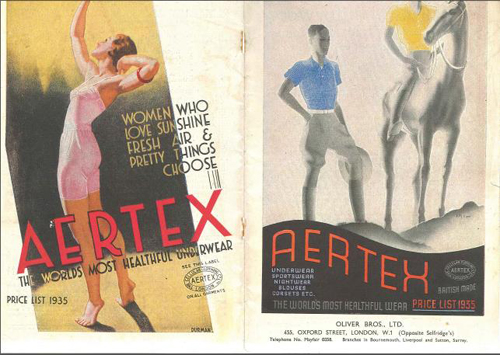
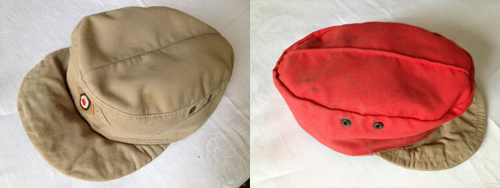
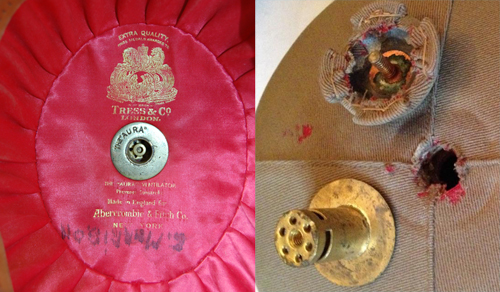
Hello Roland, You have a very interesting website here! I am very much enjoying the various sun helmets and related facts. I have a little to add to the information above pertaining to the use of the color red: I believe it was in 1939 or 1940, that the University of Hamburg, by request of the German government [in anticipation of their involvement in North Africa], discovered in their testing, that the color red, when used as a lining in caps, struck the best balance of all colors in allowing the heat from the top of the head to escape through the fiber of the material to the outside, while simultaneously not allowing the heat from above (sun generated), to enter!!! How typically thorough of the German military…. There after, the German Army developed the iconic Deutsches Afrikakorps M1940 visored field cap. Rightfully considered the most comfortable and popular headgear worn by German soldiers during all of WW II. Regards, Matthew
perhaps the reason is the one posted by matthew . i offer an alternative . the danish preben j krannik says in his book uniforms of the world that the fabric of the imperial russian field uniforms at the outbreak of wwi was quite original the warp was made of a seven coloured thread and the other threads were kaki or grey green this was intended as a form of intencinal reinforcemnt of the camouflage efect